
|
|

December 2, 2005
Kansas City's KCMO, WHB and KCXL
By SCOTT FYBUSH
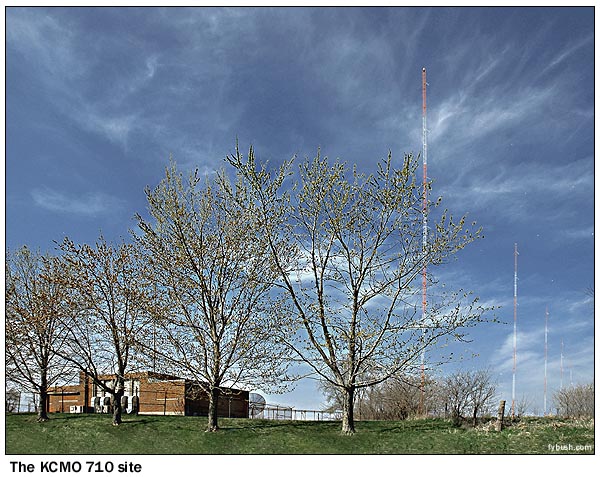
For the next few weeks, we're featuring some of the images you'll find in our new Tower Site Calendar 2006, along with some stories and extra pictures from each visit. This week, it's our April 2005 trip to Missouri, a journey that was only partially intended to get tower photos - there was also a numismatic convention involved, plus some research for the (still) forthcoming "Airwaves of New York, Volume II."
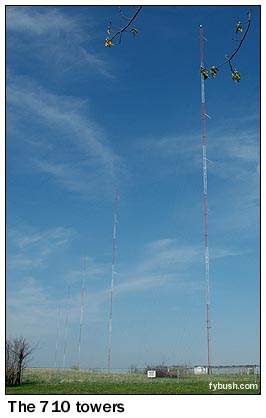 But
when the final morning of our trip yielded beautiful blue skies
and nice warm weather, and we had a few hours to kill en route
to the airport, we couldn't resist the chance to spend a little
more time at two sites we'd visited during the Big
Trip of 2001, as well as one that was brand-new to us.
But
when the final morning of our trip yielded beautiful blue skies
and nice warm weather, and we had a few hours to kill en route
to the airport, we couldn't resist the chance to spend a little
more time at two sites we'd visited during the Big
Trip of 2001, as well as one that was brand-new to us.
The site you see at the top of the page - and on the September 2006 page of the calendar - spent most of its history as WHB, one of the most significant stations in Kansas City's radio legacy. WHB already had 26 years of broadcasting under its belt, most of it as a daytimer on 860 and then 880, when it moved to this spot in Clay County, northwest of Kansas City, in May 1948. At that point, the station became a full-timer on 710, with 10 kW day and 5 kW at night, and within a few years it was one of the nation's pioneering top-40 stations under the legendary Todd Storz.
WHB remained under Storz ownership until 1985, when it was sold to Roy Disney's Shamrock group. It programmed oldies for a few years, then was sold again and became a farm-oriented station.
And then, at midnight on October 8, 1997, WHB traded frequencies and transmitter sites with its neighbor up there northwest of Kansas City - the 50 kW/5 kW facility on 810 that was long known as KCMO. (We'll see it in a moment.)
The move was a win for both stations - WHB gained the huge daytime 50 kW footprint of the 810 facility, while KCMO picked up somewhat better night coverage of suburban Johnson County, Kansas from 710's night pattern, without giving up too much daytime coverage in the process.
The only real losers in the deal were fans of prominent displays of call letters at transmitter sites: at one time, giant stainless-steel "W H B" letters graced one corner of the transmitter building roof out there on North Eastern Avenue, a couple of miles outside the I-435 loop. Those, of course, went away. Fortunately, the rest of the 1948 industrial Deco design survived, and it's still a mighty nice site to look at, especially in spring with the trees in bloom.
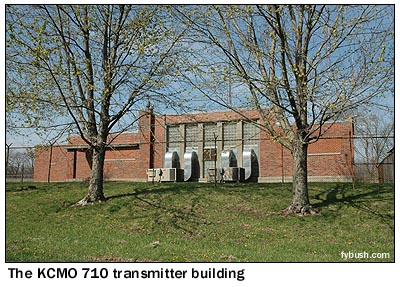
|
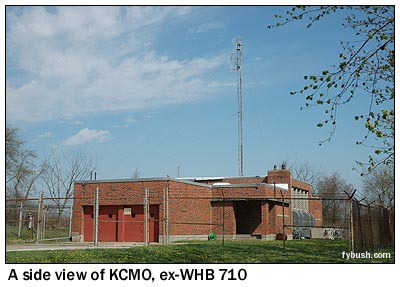
|
From the 710 site, it's only a mile or so west along Cookingham Road to the five-tower site of 810, which today occupies a very visible spot where US 169 meets the I-435 loop. This site, now sports talker WHB, was KCMO for most of its history - but those distinctive calls were relatively late arrivals to the Kansas City dial. KWKC was a small station at 1370 on the dial in 1936, when it took those KCMO calls, but it grew quickly. In 1939, it moved from the "local" channel at 1370 to a 5 kW regional channel, 1450 (later 1480), and in September 1947 it made the move to 810, building the 50 kW day/5 kW night facility up on Cookingham. (I'm indebted to my friend Mark Roberts' excellent Pioneer Radio History site for the historical details on Kansas City broadcasters past and present.)
It's seen in the photo montage below - those five towers are so widely spaced that they're almost impossible to get in a single frame.
(And look very carefully at the brick on the front of the building to see the ghosts of the "K C M O" letters that once graced this facility.)
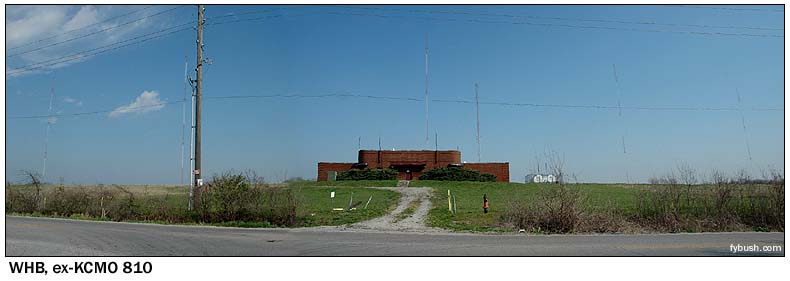
From here, we've got one more radio stop to make, thanks to an invitation from Dave Brewer to stop by and see the station where he works. That would be little KCXL (1140) in Liberty, a pleasant small town about 15 miles northwest of downtown Kansas City.
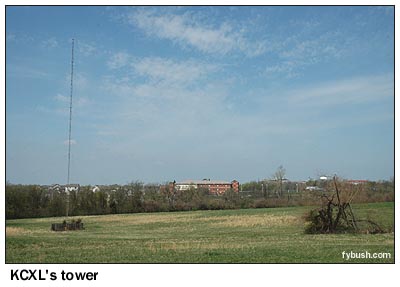
|
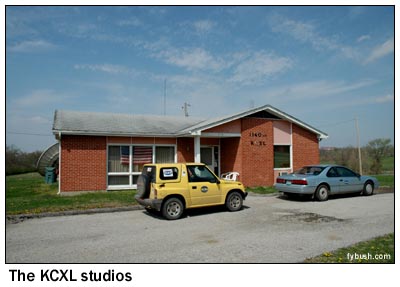
|
This mighty 500-watt daytimer took to the air in 1967 as KBIL, spent much of the seventies playing country, and then spent a year as AC KFIX before going oldies as KLDY. (Along the way, it picked up an FM sister station at 106.5; it was sold off to separate owners in 1984 and is today country WDAF-FM.)
The station became KCXL in 1984, playing urban contemporary music from studios in Kansas City. A decade later, it came back home to Liberty, reoccupying the studios in this little building on La Frenz Road, east of Liberty.
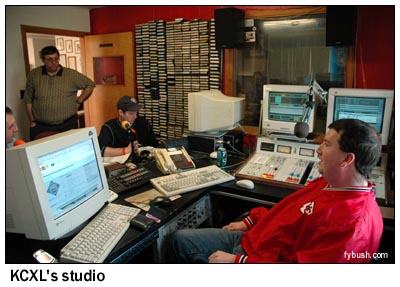
|
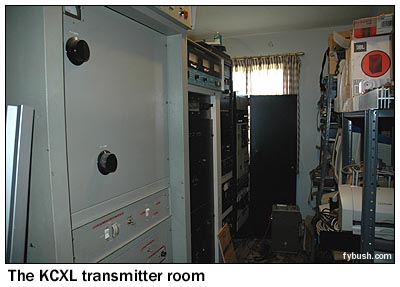
|
That's where we find it this Saturday morning, with the "Integrity Sports" guys (who lease most of Saturday on the station) on the air, and a nifty assortment of transmitters new and old in the next room back. (Yes, it's a station where you can see the transmitters from the studio through a big glass window. We love those...)
The current transmitter, incidentally, is a little BE solid-state AM500 back there in the rightmost rack.
(Some of this gear may be moving soon, though - KCXL's owner, Pete Schartel, is building another AM station at the far southern end of the market. KCTO, licensed to Cleveland, Missouri, will run 210 watts into four towers on 1160. We'll have to head back to Kansas City to see that one when it's all done!)
LIKE THAT 710 PICTURE? You should see it in printed form, in the 2006 Tower Site Calendar! Click here for ordering information!
- Previous Site of the Week: Four Shopping Mall AMs (newly updated!)
- Next Week: Several Scranton AMs
- Site of the Week INDEX!
- How can you help support Site of the Week? Click here!
- Submit your suggestions for a future Site of the Week!
